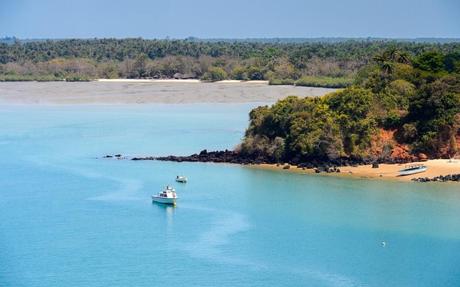For travelers, the desire to 'discover' truly untouched destinations is just that; a desire. But in 2019 I set out to explore a group of 88 islands and islets in the Atlantic Ocean that few had heard of: the Bissagos Archipelago.
New to cruise itineraries, it turned out to be one of the most exciting places I've been - a prelapsarian paradise that's rare these days. But then Covid struck, itineraries were suspended and the Bissagos were forgotten again. Five years later, the sun is once again shining on the islands, with French cruise line Ponant resuming its itineraries to this remote spot next year - their luxury ships are one of the few ways to visit these islands in comfort and safety.

A UNESCO Biosphere Reserve since 1996, this 8,000 square kilometer area is protected from tourism due to its inaccessibility, lack of infrastructure and transport, and the unreliable political situation that has plagued Guinea-Bissau - one of the poorest countries in the world - ever since . it became independent from Portugal in the 1970s. Also spelled Bijagós (which means 'perfect people'), the islands have only 23 inhabited islands - and you not only need the permission of the islanders to go ashore, but some of the islands, which are considered sacred , are even completely off limits.
Accompanied by dolphins, we sailed at night, along the archipelago to avoid rocks and sandbanks in the notoriously shallow waters. e century navigation maps - the only ones in existence - that serve us well. In the morning scouts ventured forward to test the lay of the land and smooth out our arrival with the islanders.
But paradise, as Eve would testify, is not without pitfalls. "In the jungle you must stick to the paths at all times," our expedition leader emphasized at every briefing. 'There are mambas in the trees and horned vipers camouflaged in the grass. And depending on the tides you may have to wade ashore for half an hour - watch out for the stingrays." Not to mention the bull sharks whose swimming - so tempting, from the sandy beaches - is highly inadvisable except in designated areas.
We trekked through the savannah dotted with acacia trees, following footprints and wading through leech-infested waters to see the famous saltwater hippos. In the dry season they inhabit the mangrove swamps; we found them in a crocodile-infested lake, nibbling on water lilies.
Despite the Bissagos' rich biodiversity, the fascination of these islands lies in their 30,000-strong population. They have a strictly hierarchical society, based on age-related class groups that everyone has to pass through, through a series of grueling initiation rituals.
To reach the villages of mud and straw huts, we passed through sun-drenched forests of thick ferns, palm, mango, cashew and kapok trees; passed clearings where crops are rotated; sailed by Zodiac through beautiful, increasingly narrow channels of mangrove - a bird paradise - where children played and dived in dug-out canoes.
On the island of Carache we followed the sound of drums and found Nathalie, queen and priestess of her hundred-strong community. She was expecting us, stately in a colorful headscarf and a toga of dried palm leaves, seated with two female elders on a fallen tree trunk, while a little boy sat at her feet sifting bright orange palm nuts. There were rice fields all around. Nathalie led us to where a group of young people were gathered, draped and crowned with leaves, wearing shell anklets. They started dancing and it was as if the rice fields had come to life.
Although there are differences between the islands in both customs and the local Bidyogo language, dance was a common feature of our greeting in each village and is an important element of initiation. Rhythmic, energetic, elemental performances by young men and women dressed in zoomorphic headdresses.
Bolama, the closest island to the mainland and the capital of Portuguese Guinea from the 1870s to the 1940s, offered a very different experience. "Brancos! Brancos!" ["White people!"] a little boy shouted as we landed and walked past colorful wooden pirogues - the only way the islanders could reach the mainland - and fishermen mending their nets the old-fashioned way, stretched tightly around their big toe. For starters, Bolama has beautiful stone mansions - the legacy of competing British and Portuguese settlers - that are now crumbling, roofless, melancholy ruins. Here I saw my first signs of trade: blue barrels of strong 'cashew wine', bound for the mainland; and a shop, empty except for one toilet, which stood like a throne in the center of the room. "They don't sell," laughed Laurent, our guide, "nobody uses them!"
The governor waited outside his home, another beautiful ruin with balconies. He thanked us for coming - "the first cruise ship," he said. There were speeches and then more dancing. It was perhaps my favorite spectacle of all: young boys, caked in mud and equipped with spears, like fearsome warriors with, instead of gourds, empty Coca-Cola cans incongruously strung around their waists.
As I wandered around the city, I was surprised to find both a Catholic and a Protestant church. "Some people convert to Christianity to escape the rigors of initiation," Laurent said. "But in their hearts they all remain animists."
Lost in time, Bolama turned out to be a fascinating bridge between two worlds. And it was the closest I got to "civilization" as we know it all week.
The next eight-night "Adventure in the Bissagos Islands" will take place aboard Le Lyrial, departing from Dakar on April 7, 2025. Prices from €5,490 pp, excluding flights. www.ponant.com